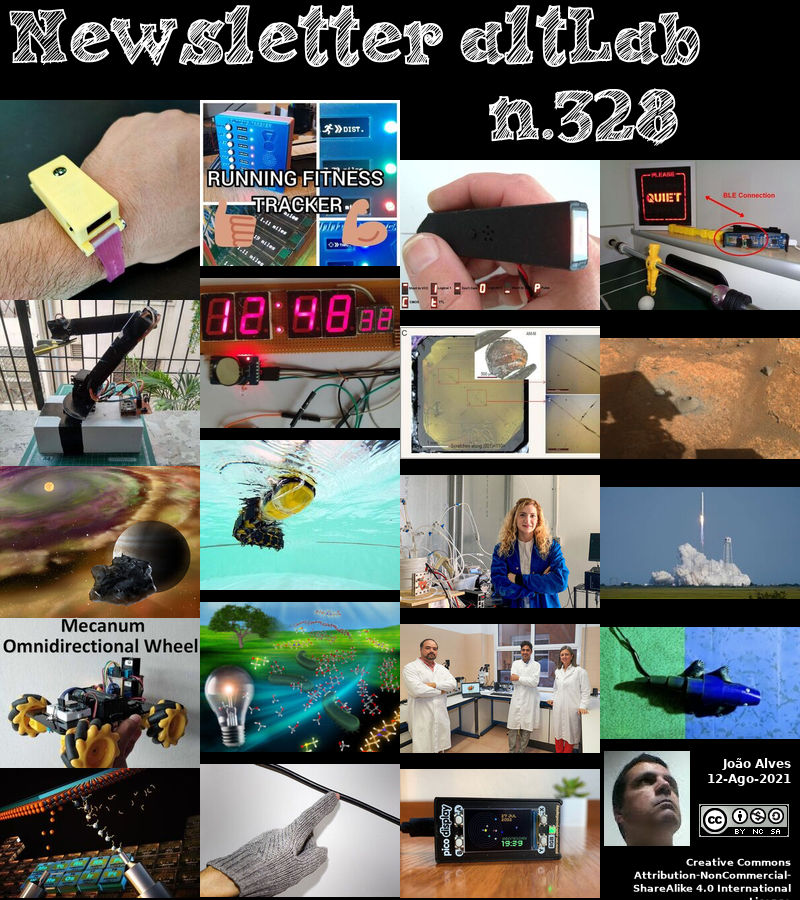2021-08-12 - Nº 328
Editorial
Esta é a Newsletter Nº 328 que se apresenta com o mesmo formato que as anteriores. Se gostar da Newsletter partilhe-a!
Todas as Newsletters encontram-se indexadas no link.
Esta Newsletter tem os seguintes tópicos:
Faz hoje anos que nascia, em 1881, o inventor norte-americano Vincent Hugo Bendix. Ele desenvolveu sistemas para automóveis e aviões e empresas para os fabricar. O seu primeiro, a efémera Bendix Company de Chicago (1907-9) fabricou um carro chamado Bendix Buggy. Em 1910, inventou a unidade Bendix que tornou possível o auto-arranque eléctrico. Utilizava uma engrenagem para engatar com o motor a baixa velocidade de rotação e depois andar para trás, desengatando-se automaticamente a uma velocidade mais alta. O primeiro sistema de travagem de quatro rodas para automóveis foi a sua criação. Entrou na produção de sistemas de aviação em 1929, com a Bendix Aviation Corporation (mais tarde, passou a chamar-se Bendix Corporation), e iniciou a Bendix Helicopters, Inc. em 1942. Durante a II Guerra Mundial, a Bendix foi a principal fonte da electrónica de aviação dos EUA.
Faz também hoje anos que nascia, em 1887, o Físico teórico austríaco Erwin Schrödinger. Ele partilhou o Prémio Nobel da Física de 1933 com o físico britânico P.A.M. Dirac. Erwin Schrödinger tomou o conceito de Louis de Broglie de partículas atómicas como tendo propriedades semelhantes às ondas, e modificou o anterior modelo Bohr do átomo para acomodar a natureza ondulatória dos electrões. Isto deu um grande contributo para o desenvolvimento da mecânica quântica. Schrödinger percebeu que as possíveis órbitas de um electrão estariam confinadas àquelas em que as suas ondas de matéria se fecham num número exacto de comprimentos de onda. Esta condição, semelhante a uma onda estacionária, seria responsável por apenas certas órbitas serem possíveis, e nenhuma possível entre elas. Isto forneceu uma explicação para linhas discretas no espectro de átomos excitados.
Em 1960, os Estados Unidos lançaram o primeiro satélite de telecomunicações, Echo 1, do Cabo Canaveral, embalado num foguetão Thor-Delta. Na altitude para a baixa órbita terrestre, acima de quase toda a atmosfera terrestre, o satélite foi implantado e insuflado com gás a baixa pressão para formar um balão esférico de 30,5 m de diâmetro feito de Mylar metalizado, com 12,7-μm de espessura. Assim, é conhecido como um satélite balão, como originalmente concebido por William J. O'Sullivan (26 de Janeiro de 1956). A sua órbita era de cerca de 1600 km. Era meramente passivo, para reflectir sinais de micro-ondas entre pontos da Terra, semelhante à forma como a Lua reflecte a luz enquanto o Sol está abaixo do horizonte. O Echo 1 permaneceu em órbita até 24 de Maio de 1968.
Faz hoje 40 anos que era lançado o IBM PC, o primeiro computador pessoal. A IBM introduziu o PC por um preço base de $1,600. O PC foi desenvolvido em menos de um ano nas instalações da IBM em Boca Raton, Florida, utilizando componentes existentes off-the-shelf. A IBM-PC estabeleceu o domínio do sistema operativo da Microsoft. O desenho do hardware do PC IBM também se tornou o padrão da indústria para PC compatíveis, com o barramento ISA. A sua velocidade de processador Intel 8080 era de 4,77 MHz, e utilizava desde 16K até 640K de memória. As opções de armazenamento de dados incluíam unidades de disquetes de 5,25", fita, e mais tarde discos rígidos.
Hoje à noite vamos ter o pico da famosa chuva de meteoros das Perseidas que ocorre entre 17 de Julho e 24 de Agosto, entre as 20h e as 23h (Hora Legal) com uma taxa horária prevista de 110 meteoros por hora, se as condições de observação estiverem perfeitas. As Perseidas são a chuva de meteoros mais impressionante e popular do ano, por terem uma alta taxa de meteoros e ocorrerem todos os anos no verão (no hemisfério norte) sob temperaturas agradáveis e noites estreladas. São provocadas pela passagem da Terra pelos fragmentos do cometa 109P / Swift-Tuttle, que foram deixados para trás aquando a sua passagem. A órbita deste cometa tem um período de 133 anos e a última vez que entrou no sistema solar interno foi em 1992. O radiante desta chuva de meteoros, ou seja, o ponto de onde parecem sair os traços das suas estrelas cadentes, está localizado na constelação do Perseu.
Na Newsletter desta semana apresentamos diversas noticias, artigos científicos, projetos de maker assim como alguns videos interessantes.
 João Alves ([email protected])
João Alves ([email protected])
O conteúdo da Newsletter encontra-se sob a licença  Creative Commons Attribution-NonCommercial-ShareAlike 4.0 International License.
Creative Commons Attribution-NonCommercial-ShareAlike 4.0 International License.
Novidades da Semana

The Perseids in 2021
"The famous Perseid meteor shower occurs between July 17 and August 24, 2021, peaking on August 12 between 8:00 pm and 11:00 pm (Legal Time) with a predicted hourly rate of 110 meteors per hour, if the observation conditions are perfect. The Perseids are the most impressive and popular meteor shower of the year, as they have a high meteor rate and occur every year in summer (in the northern hemisphere) under pleasant temperatures and starry nights. They are caused by the passage of the Earth by the fragments of comet 109P / Swift-Tuttle, which were left behind during its passage. The orbit of this comet has a period of 133 years and the last time it entered the inner solar system was in 1992. The radiant of this meteor shower, that is, the point from which the traces of its shooting stars seem to come out, is located in constellation of Perseus. The intensity of the Perseids varies from year to year, in part due to lunar conditions." [...]
Outras Notícias

Samsung Introduces the Industry’s First 5nm Processor Powering the Next Generation of Wearables
"The Exynos W920 offers high performance, efficiency and LTE connectivity packed in the industry’s smallest form factor Samsung Electronics, a world leader in advanced semiconductor technology, today announced its new wearable processor, the Exynos W920. The new processor integrates an LTE modem and is the first in the industry to be built with an advanced 5-nanometer (nm) extreme ultra-violet (EUV) process node, offering powerful yet efficient performance demanded by next-generation wearable devices. “Wearables like smartwatches are no longer just a cool gadget to have. They’re now a growing part of our lifestyles to keep you fit, safe and alert,” said Harry Cho, vice president of System LSI marketing at Samsung Electronics. “With the Exynos W920, future wearables will be able to run applications with visually appealing user interfaces and more responsive user experiences while keeping you connected on the go with fast LTE.” The Exynos W920 packs two Arm® Cortex®-A55 cores for high-performing yet power-efficient processing and an Arm Mali™-G68 GPU that boasts improved CPU performance around 20-percent and ten times better graphics performance than its predecessor. With upgraded cores and improved performance, the Exynos W920 enables faster application launches and more interactive eye-catching 3D graphical user interface (GUI) on a device’s qHD (960×540) display." [...]
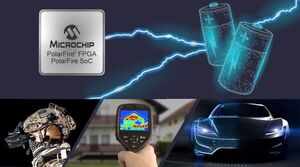
Mid-Range FPGAs Reach the Next Power and Performance Milestone for Edge Compute Systems
"Microchip’s new low-density PolarFire® devices consume half the static power of alternatives while providing world’s smallest thermal footprint Edge compute systems need compact programmable devices with low power consumption and a small enough thermal footprint to eliminate fans and other heat mitigation while providing robust compute horsepower. Microchip Technology Inc. (Nasdaq: MCHP) has solved this challenge by cutting static power consumption for its mid-bandwidth Field Programmable Gate Arrays (FPGAs) and FPGA System-on-Chip (SoC) devices in half and giving them the smallest thermal footprint and best performance and compute horsepower compared to all alternative devices in their class. “Our new PolarFire FPGAs and FPGA SoCs reduce our customers’ system costs while enabling them to solve difficult thermal management challenges without having to forfeit bandwidth,” said Bruce Weyer, vice president of Microchip’s FPGA business unit. “The award-winning PolarFire FPGA platform already delivered the industry’s best combination of power and performance, and now we have reduced power consumption by up to 50 percent or more with the introduction of lower density offerings, while maintaining best-in-class capabilities on these platforms. No other offering in this class can match these capabilities.” With their ultra-low power consumption, Microchip’s latest low-density PolarFire FPGAs (MPF050T) and PolarFire SoC (MPFS025T) additions exceed the performance/power metrics of any low-density FPGA or SoC FPGA alternatives in the market, with fast FPGA fabric and signal processing capabilities, the most capable transceivers and the industry’s only hardened application class RISC-V® architecture-based processor complex with 2 megabytes (MB) of L2 cache and Low-Power DDR4 (LPDDR4) memory support. Extending the portfolio with a 25K logic elements multi-core RISC-V SoC and a 50K logic elements FPGA opens new application possibilities." [...]
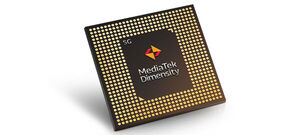
MediaTek Announces Dimensity 920 and Dimensity 810 Chips for 5G Smartphones
"Bringing brilliant imaging, smarter displays and boosted performance together for incredible mobile experiences MediaTek today announced the new Dimensity 920 and Dimensity 810 chipsets, the latest additions to its Dimensity 5G family. This debut gives smartphone makers the ability to provide boosted performance, brilliant imaging and smarter displays to their customers. Designed for powerful 5G smartphones, the Dimensity 920 balances performance, power and cost to provide an incredible mobile experience. Built using the 6nm high-performance manufacturing node, it supports intelligent displays and hardware-based 4K HDR video capture, while also offering a 9% boost in gaming performance compared to its predecessor, the Dimensity 900. The Dimensity 810 is built using the 6nm high-performance manufacturing node. It provides Arm Cortex-A76 CPU speeds up to 2.4GHz, premium camera features including artistic AI-color in collaboration with Arcsoft, and advanced noise reduction techniques for superb low-light photography." [...]

Revolutionizing augmented reality with Infineon’s new MEMS scanner for eyeglasses and head-up displays
"What if your everyday eyeglasses became the next media for augmented reality applications? What if every car could display valuable data on the whole windshield to securely guide you through the traffic? The new MEMS* scanner solution from Infineon Technologies AG (FSE: IFX / OTCQX: IFNNY), comprising a MEMS mirror and MEMS driver, allows completely new product designs. Its miniature size and low power consumption are the basis for making augmented reality (AR) solutions more widely available for consumer applications such as wearables and for automotive head-up displays. “Augmented reality solutions enrich real environments with valuable digital data and help people to move around more conveniently and safely in daily life, for business and leisure activities, but especially on the street,” said Charles Chan, head of Infineon’s automotive MEMS product line. “Maps, infotainment or messages projected on everyday glasses guide people to the nearest supermarket or shared car park around the corner." [...]

New I2C Serial EEPROM Introduces 3.4MHz High-Speed Mode Operation, Software Write-Protection and Factory Programmed Serial Numbers
"Industry First 3.4 MHz I2C Serial EEPROM Closes the Gap in Trade-Offs Between SPI and I2C Protocols I2C and SPI are two of the most widely used serial communication buses for embedded systems and each comes with its own set of advantages and disadvantages. SPI is by nature the faster protocol, but that comes at the expense of higher pricing and limited scalability. To close the trade-off gap between I2C and SPI in Serial EEPROMs, Microchip Technology Inc. (Nasdaq: MCHP) has released the first commercially available I2C Serial EEPROM with support for 3.4 Mbit/s data rates, the 24CS512, making it the fastest I2C EEPROM in the world. Until now, I2C Serial EEPROM bus speeds have been limited to 1 MHz, which is sometimes not fast enough, particularly for larger memory size applications. Engineers requiring faster speeds out of their Serial EEPROMs usually choose SPI, which is typically specified for up to 20 MHz speeds. However, they have paid approximately 30 percent higher prices for the added speed while making additional sacrifices in noise susceptibility, design complexity and scalability." [...]
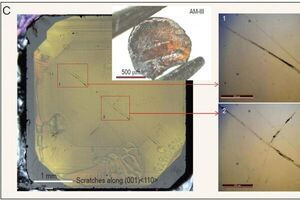
Chinese scientists develop glass as hard as a diamond
"Using a diamond to cut glass is not news, but a research team in northern China recently developed the world’s hardest glassy material that can leave a deep scratch on the surface of a diamond with ease. The (tentatively named) AM-III, a transparent, somewhat yellowish material made entirely of carbon, reached 113 gigapascals (GPa) in a Vickers hardness test. In comparison, a natural diamond stone usually scores 50 to 70, with some man-made pieces topping at 100 GPa. Though mass production could be years away, and the price is unlikely to be cheap, a bulletproof window made with the AM-III could be 20 to 100 times tougher than some mainstream products currently in use. The glassy material does not look as attractive as jewellery, but it has some wide applications in the hi-tech industry, the researchers say. The AM-III, for instance, is a semiconductor almost as efficient as silicon." [...]

NASA Spacecraft Provides Insight into Asteroid Bennu’s Future Orbit
"In a study released Wednesday, NASA researchers used precision-tracking data from the agency’s Origins, Spectral Interpretation, Resource Identification, Security-Regolith Explorer (OSIRIS-REx) spacecraft to better understand movements of the potentially hazardous asteroid Bennu through the year 2300, significantly reducing uncertainties related to its future orbit, and improving scientists’ ability to determine the total impact probability and predict orbits of other asteroids. The study, titled “Ephemeris and hazard assessment for near-Earth asteroid (101955) Bennu based on OSIRIS-REx data,” was published in the journal Icarus. “NASA’s Planetary Defense mission is to find and monitor asteroids and comets that can come near Earth and may pose a hazard to our planet,” said Kelly Fast, program manager for the Near-Earth Object Observations Program at NASA Headquarters in Washington. “We carry out this endeavor through continuing astronomical surveys that collect data to discover previously unknown objects and refine our orbital models for them. The OSIRIS-REx mission has provided an extraordinary opportunity to refine and test these models, helping us better predict where Bennu will be when it makes its close approach to Earth more than a century from now.” In 2135, asteroid Bennu will make a close approach with Earth. Although the near-Earth object will not pose a danger to our planet at that time, scientists must understand Bennu’s exact trajectory during that encounter in order to predict how Earth’s gravity will alter the asteroid’s path around the Sun – and affect the hazard of Earth impact." [...]

JEDEC Publishes New and Updated Standards for Low Power Memory Devices Used in 5G and AI Applications
"JEDEC Solid State Technology Association, the global leader in standards development for the microelectronics industry, today announced the publication of JESD209-5B, Low Power Double Data Rate 5 (LPDDR5). JESD209-5B includes both an update to the LPDDR5 standard that is focused on improving performance, power and flexibility, and a new LPDDR5X standard, which is an optional extension to LPDDR5. Taken together, LPDDR5 and LPDDR5X are designed to significantly boost memory speed and efficiency for a variety of uses including mobile devices, such as 5G smartphones and artificial intelligence (AI) applications. Developed by JEDEC’s JC-42.6 Subcommittee for Low Power Memories, JESD209-5B is available for download from the JEDEC website. Key updates to this latest version of LPDDR5 include: Speed extension up to 8533 Mbps (versus up to 6400 Mbps in the previous revision) Signal Integrity improvements with TX/RX equalization Reliability improvements via the new Adaptive Refresh Management feature The new LPDDR5X component of JESD209-5B is an optional extension intended to offer higher bandwidth and simplified architecture in support of enhanced 5G communication performance, and is designed for applications ranging from automotive to high resolution augmented reality/virtual reality and edge computing using AI. “As one of the fastest memories in recent memory to move from concept to industry standard, LPDDR5x is not only a turbo-charged pacesetter for the smartphone marketplace,” according to Mian Quddus, JEDEC’s Chairman of the Board of Directors, “but a power-conserving solution that will set the bandwidth bar considerably higher in taking 5G into a wider consumer embrace worldwide.” Industry Support Micron Technology: “As a leader in low-power memory, Micron collaborated closely with other JEDEC members to define LPDDR5X, providing the mobile ecosystem a critical advancement in higher bandwidth,” said Osamu Nagashima, Micron senior manager of mobile systems architecture and vice chair of the JEDEC low power memories subcommittee." [...]

Indian rocket suffers catastrophic failure during launch, Earth-watching satellite lost
"India's first launch of 2021 has ended in failure. An Indian rocket carrying a new Earth-observation satellite for the Indian Space Research Organisation (ISRO) suffered a catastrophic failure shortly after launching early Thursday (Aug. 12) from the country's Satish Dhawan Space Centre on Sriharikota Island in eastern India. The liftoff occurred at 5:43 a.m. local time in India (8:13 p.m. EDT Aug 11/0013 GMT). The launch failure, the first for India since 2017, occurred sometime past the six-minute mark when the mission's rocket, the 12-story-tall Geosynchronous Satellite Launch Vehicle, was expected to have ignited its cryogenic third stage. That third stage ignition did not happen, ISRO officials said. "Performance of first and second stages was normal." [...]

SpaceX is buying satellite data start-up Swarm, in a rare acquisition by Elon Musk’s space company
"SpaceX is acquiring satellite data start-up Swarm Technologies, in a rare deal by Elon Musk’s space company that expands the team — and possibly the technological capabilities — of its growing Starlink internet service. Swarm, which has 120 of its tiny SpaceBEE satellites in orbit, reached an agreement with SpaceX on July 16 to merge, according to an Aug. 6 filing with the Federal Communications Commission. The company will become “a direct wholly-owned subsidiary of SpaceX upon consummation of the Proposed Transaction,” Swarm wrote in the filing. Terms and financial details about the deal were not disclosed. SpaceX and Swarm did not respond to CNBC’s requests for comment. Swarm last completed a fundraising round in January 2019 at a $85 million valuation, according to Pitchbook." [...]

SpaceX stacks Starship atop massive booster for 1st time to make the world's tallest rocket
"SpaceX's newest Starship prototype was briefly placed atop of its massive booster for the first time on Friday (Aug. 6), setting a new record for the world's tallest rocket ahead of a planned orbital test flight this year. Engineers performed the stacking test at the SpaceX Starbase facility in South Texas, near the village of Boca Chica, in view of livestreams from NASA Spaceflight and Spadre.com. SpaceX has not commented on the stacking procedure yet on Twitter, although founder Elon Musk sent an update suggesting the company actually wanted to complete the stacking Thursday (Aug. 5), a few hours after Starship completed its rollout to the launch pad, but winds were too high. Starship SN20 ("Serial No. 20") and its Super Heavy booster were mated for about an hour for fit checks, during which time the two vehicles posed a towering site. Super Heavy alone stands 230 feet (70 meters) tall and Starship SN4 added another 165 feet (50 m) of height." [...]
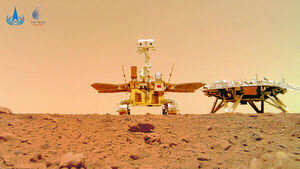
China's Mars rover travels over 800 meters on red planet
"China's Mars rover Zhurong has traveled more than 800 meters on the surface of the red planet as of Friday, according to the Lunar Exploration and Space Program Center of the China National Space Administration. Zhurong has been traversing a complex terrain full of rocks, craters and dunes, and its rear hazard-avoidance camera captured a picture of the rover just moving across the rocks. As of August 6, 2021, the rover has worked on the surface of Mars for 82 Martian days and the orbiter has been in orbit for 379 days. The two are in good condition and functioning properly. A Martian day is approximately 40 minutes longer than a day on Earth. " [...]

NASA’s Perseverance Team Assessing First Mars Sampling Attempt
"Data sent to Earth by NASA’s Perseverance rover after its first attempt to collect a rock sample on Mars and seal it in a sample tube indicate that no rock was collected during the initial sampling activity. The rover carries 43 titanium sample tubes, and is exploring Jezero Crater, where it will be gathering samples of rock and regolith (broken rock and dust) for future analysis on Earth. “While this is not the ‘hole-in-one’ we hoped for, there is always risk with breaking new ground,” said Thomas Zurbuchen, associate administrator of NASA’s Science Mission Directorate in Washington. “I’m confident we have the right team working this, and we will persevere toward a solution to ensure future success.” Perseverance’s Sampling and Caching System uses a hollow coring bit and a percussive drill at the end of its 7-foot-long (2-meter-long) robotic arm to extract samples. Telemetry from the rover indicates that during its first coring attempt, the drill and bit were engaged as planned, and post-coring the sample tube was processed as intended. “The sampling process is autonomous from beginning to end,” said Jessica Samuels, the surface mission manager for Perseverance at NASA’s Jet Propulsion Laboratory in Southern California." [...]

Space station supplies launched with a pizza delivery for 7
"Northrop Grumman's latest space station delivery includes pizza for seven. The company's Cygnus cargo ship rocketed away from Virginia’s eastern shore Tuesday. It should reach the International Space Station on Thursday. The 8,200-pound (3,700-kilogram) shipment includes fresh apples, tomatoes and kiwi, along with a pizza kit and cheese smorgasbord for the seven station astronauts. Also flying: a mounting bracket for new solar wings launching to the orbiting lab next year, a material simulating moon dust and dirt that will be used to create items from the space station's 3D printer, slime mold for a French educational experiment called Blob and an infrared-detecting device meant as a prototype for future tracking satellites. It is Northrop Grumman’s 16th supply run for NASA and its biggest load yet." [...]
Ciência e Tecnologia

Using aluminum and water to make clean hydrogen fuel — when and where it’s needed
"MIT team produces practical guidelines for generating hydrogen using scrap aluminum. As the world works to move away from fossil fuels, many researchers are investigating whether clean hydrogen fuel can play an expanded role in sectors from transportation and industry to buildings and power generation. It could be used in fuel cell vehicles, heat-producing boilers, electricity-generating gas turbines, systems for storing renewable energy, and more. But while using hydrogen doesn’t generate carbon emissions, making it typically does. Today, almost all hydrogen is produced using fossil fuel-based processes that together generate more than 2 percent of all global greenhouse gas emissions. In addition, hydrogen is often produced in one location and consumed in another, which means its use also presents logistical challenges." [...]

Building Blocks: New Evidence-Based System Predicts Element Combination Forming High Entropy Alloy
"New method overcomes the drawbacks typically associated with data-driven methods such as data bias and poor availability Building prediction models for high entropy alloys (HEAs) using material data is challenging, as datasets are often lacking or heavily biased. Now, researchers have developed a new evidence-based recommender system that determines various element combinations for potential HEAs. Unlike conventional data-driven techniques, this method has the added ability to recommend potential HEA candidates from limited amounts of experimental data. Their method can facilitate the development of alloys that have applications as advanced functional materials. High entropy alloys (HEAs) have desirable physical and chemical properties such as a high tensile strength, and corrosion and oxidation resistance, which make them suitable for a wide range of applications. HEAs are a recent development and their synthesis methods are an area of active research." [...]

‘Cool’ kids in the cosmos may not be so unique
"Rice models infer small stars share similar dynamics to our sun, key to planet habitability Stars scattered throughout the cosmos look different, but they may be more alike than once thought, according to Rice University researchers. New modeling work by Rice scientists shows that “cool” stars like the sun share the dynamic surface behaviors that influence their energetic and magnetic environments. This stellar magnetic activity is key to whether a given star hosts planets that could support life. The work by Rice postdoctoral researcher Alison Farrish and astrophysicists David Alexander and Christopher Johns-Krull appears in a published study in The Astrophysical Journal. The research links the rotation of cool stars with the behavior of their surface magnetic flux, which in turn drives the star’s coronal X-ray luminosity, in a way that could help predict how magnetic activity affects any exoplanets in their systems. The study follows another led by Farrish and Alexander that showed a star’s space “weather” may make planets in their “Goldilocks zone” uninhabitable." [...]
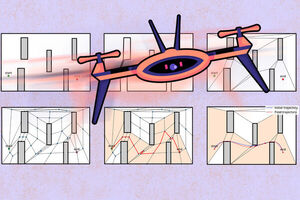
System trains drones to fly around obstacles at high speeds
"New algorithm could enable fast, nimble drones for time-critical operations such as search and rescue. If you follow autonomous drone racing, you likely remember the crashes as much as the wins. In drone racing, teams compete to see which vehicle is better trained to fly fastest through an obstacle course. But the faster drones fly, the more unstable they become, and at high speeds their aerodynamics can be too complicated to predict. Crashes, therefore, are a common and often spectacular occurrence. But if they can be pushed to be faster and more nimble, drones could be put to use in time-critical operations beyond the race course, for instance to search for survivors in a natural disaster." [...]

UNF physics researchers discover new electronic phenomenon
"Physics researchers at the University of North Florida’s Atomic LEGO Lab discovered a new electronic phenomenon they call “asymmetric ferroelectricity”. The research led by Dr. Maitri Warusawithana, UNF physics assistant professor, in collaboration with researchers at the University of Illinois and the Arizona State University, demonstrated this phenomenon for the first time in engineered two-dimensional crystals. This discovery of asymmetric ferroelectricity in engineered crystals comes exactly 100 years following the discovery of ferroelectricity in certain naturally occurring crystals. Ferroelectric crystals – crystals that show two equal bistable polarization states – are now used in many high-tech applications including solid-state memory, RFID cards, sensors and precision actuators. Utilizing atomic-scale materials design, the team of researchers has demonstrated a qualitatively new phenomenon, asymmetric ferroelectricity, for the first time. These engineered crystals lead to an asymmetric bi-stability with two unequal stable polarization states in contrast to a natural ferroelectric." [...]

Forget wearables: Future washable smart clothes powered by Wi-Fi will monitor your health
"Purdue University engineers have developed a method to transform existing cloth items into battery-free wearables resistant to laundry. These smart clothes are powered wirelessly through a flexible, silk-based coil sewn on the textile. In the near future, all your clothes will become smart. These smart cloths will outperform conventional passive garments, thanks to their miniaturized electronic circuits and sensors, which will allow you to seamlessly communicate with your phone, computer, car and other machines. This smart clothing will not only make you more productive but also check on your health status and even call for help if you suffer an accident. The reason why this smart clothing is not all over your closet yet is that the fabrication of this smart clothing is quite challenging, as clothes need to be periodically washed and electronics despise water." [...]

Swimming robot gives fresh insight into locomotion and neuroscience
"Thanks to their swimming robot modeled after a lamprey, EPFL scientists may have discovered why some vertebrates are able to retain their locomotor capabilities after a spinal cord lesion. The finding could also help improve the performance of swimming robots used for search and rescue missions and for environmental monitoring. Scientists at the Biorobotics Laboratory (BioRob) in EPFL’s School of Engineering are developing innovative robots in order to study locomotion in animals and, ultimately, gain a better understanding of the neuroscience behind the generation of movement. One such robot is AgnathaX, a swimming robot employed in an international study with researchers from EPFL as well as Tohoku University in Japan, Institut Mines-Télécom Atlantique in Nantes, France, and Université de Sherbrooke in Canada. The study has just been published in Science Robotics. “Our goal with this robot was to examine how the nervous system processes sensory information so as to produce a given kind of movement,” says Prof. Auke Ijspeert, the head of BioRob." [...]

Graphene binds drugs which kill bacteria on implants
"Bacterial infections relating to medical implants place a huge burden on healthcare and cause great suffering to patients worldwide. Now, researchers at Chalmers, have developed a new method to prevent such infections, by covering a graphene-based material with bactericidal molecules. “Through our research, we have succeeded in binding water-insoluble antibacterial molecules to the graphene, and having the molecules release in a controlled, continuous manner from the material. This is an essential requirement for the method to work. The way in which we bind the active molecules to the graphene is also very simple, and could be easily integrated into industrial processes,” explains Santosh Pandit, researcher at the Department of Biology and Biological Engineering at Chalmers, and first author of the study which was recently published in Scientific Reports. Certain bacteria can form impenetrable surface layers, or ‘biofilms’, on surgical implants, such as dental and other orthopaedic implants, and represent a major problem for healthcare globally." [...]

New solvents to break down plant cellulose for bioethanol
"Kanazawa University researchers experimented with different combinations of zwitterionic molecules to produce a solvent that is liquid below 100°C and very effective at breaking down cellulose. This research may lead to much more cost-effective and safe production of biofuels, such as ethanol from switchgrass or plant husks. Kanazawa, Japan – Scientists from the Institute of Science and Engineering at Kanazawa University have developed new solvent mixtures to break down the tough structure of plant cellulose for the production of bioethanol. These new solvents work under mild conditions, have reduced toxicity and are more environmentally friendly compared with currently available solvents. This work may lead to improved technologies for the conversion of currently unused biomass to fuel. Biofuels, such as ethanol produced from switchgrass or sugarcane, may allow us to reduce our reliance on nonrenewable fossil fuels." [...]

Magnetic patterns hidden in meteorites reveal early Solar System dynamics
"Researchers have developed a novel technique to investigate the dynamics of the early Solar System by analyzing magnetites in meteorites utilizing the wave nature of electrons. Within meteorites, the magnetic fields associated with the particles that make up the object can act as a historical record. By analyzing such magnetic fields, scientists can deduce the probable events that affected the object and reconstruct a time-lapse of what events occurred on the meteorite and when. “Primitive meteorites are time capsules of primordial materials formed at the beginning of our Solar System,” said Yuki Kimura, an associate professor at the Institute of Low Temperature Science at Hokkaido University in Japan who led the study. “To understand the physical and chemical history of the Solar System, it is crucial to analyze various types of meteorites with different origins.” While there are many meteorites available for study here on Earth, most of them originated from the asteroid belt, between Mars and Jupiter. These samples are used to study what the early Solar System looked like." [...]

Researchers develop real-time lyric generation technology to inspire song writing
"LyricJam, a real-time system that uses artificial intelligence to generate lyric lines for live instrumental music Music artists can find inspiration and new creative directions for their song writing with technology developed by Waterloo researchers. LyricJam, a real-time system that uses artificial intelligence (AI) to generate lyric lines for live instrumental music, was created by members of the University’s Natural Language Processing Lab. The lab, led by Olga Vechtomova, a Waterloo Engineering professor cross-appointed in Computer Science, has been researching creative applications of AI for several years. The lab’s initial work led to the creation of a system that learns musical expressions of artists and generates lyrics in their style. Recently, Vechtomova, along with Waterloo graduate students Gaurav Sahu and Dhruv Kumar, developed technology that relies on various aspects of music such as chord progressions, tempo and instrumentation to synthesize lyrics reflecting the mood and emotions expressed by live music. As a musician or a band plays instrumental music, the system continuously receives the raw audio clips, which the neural network processes to generate new lyric lines." [...]

Metamaterials research challenges fundamental limits in photonics
"Cornell researchers are proposing a new way to modulate both the absorptive and the refractive qualities of metamaterials in real time, and their findings open intriguing new opportunities to control, in time and space, the propagation and scattering of waves for applications in various areas of wave physics and engineering. The research published in the journal Optica, “Spectral Causality and the Scattering of Waves,” is authored by doctoral students Zeki Hayran and Aobo Chen, M.S. ’19, along with their adviser, Francesco Monticone, assistant professor in the School of Electrical and Computer Engineering in the College of Engineering. The theoretical work aims to expand the capabilities of metamaterials to absorb or refract electromagnetic waves. Previous research was limited to modifying either absorption or refraction, but the Monticone Research Group has now shown that if both qualities are modulated in real time, the effectiveness of the metamaterial can be greatly increased. These temporally modulated metamaterials, sometimes referred to as “chrono-metamaterials,” may open unexplored opportunities and enable technological advances in electromagnetics and photonics." [...]
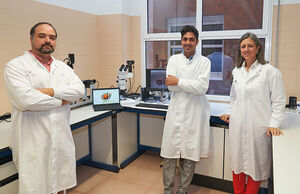
The movement of small water droplets is controlled by means of a magnet
"The Microfluidics Cluster of the UPV/EHU-University of the Basque Country has created a paramagnetic ring that encapsulates water droplets under a magnetic field A study carried out by the UPV/EHU’s Microfluidics Cluster, published by the prestigious journal Advanced Functional Materials, has presented and characterised the formation and properties of a superparamagnetic ring, which fits snugly around a drop of water due to liquid-liquid interaction, and allows the drops to be physically manipulated. The study is part of the European MAMI project, which involves multidisciplinary groups and companies from six countries. Droplet manipulation is kindling great interest in several fields, including technological applications and basic studies in dynamic systems. The Lab-on-a-chip and microfluidics community is particularly interested in the precise manipulation of small volumes of fluids, droplet microfluidics. A piece of research conducted by the UPV/EHU's Microfluidics Cluster has found that a superparamagnetic ring forms spontaneously around a water droplet when an oil-based ferrofluid is in contact with the droplet under the influence of a magnetic field and varies according to the strength of the magnetic field applied. The ring consists of an oil-based ferrofluid, a stable suspension of ferromagnetic particles in an oil phase." [...]

New Manufacturing Process Could Be Passport To Flexible Next-Gen Electronics
"A new method for manufacturing electronics which prints high-performance silicon directly onto flexible materials could lead to breakthroughs in technologies including prosthetics, high-end electronics and fully bendable digital displays. In a new paper published in the journal NPJ Flexible Electronics, engineers from the University of Glasgow’s Bendable Electronics and Sensing Technologies (BEST) group outline how they have streamlined and improved the conventional process for creating flexible large area electronics. Until now, the most advanced flexible electronics have been mainly manufactured by a process called transfer printing, a three-stage stamping process a bit like receiving an ink stamp in a passport when visiting another country. First, a silicon-based semiconductor nanostructure is designed and grown on a surface known as a substrate. In the second stage, the nanostructure is picked up from the substrate by a soft polymeric stamp. In the final stage, the nanostructure is transferred from the stamp to another flexible substrate, ready for use in bendable devices like health monitors, soft robotics, and bendable displays." [...]

Invisible barrier breakthrough a boon for electronics, artwork and more
"Curtin University researchers have found applying a thin invisible layer of graphene oxide to silicon forms an impermeable barrier, which could be used to protect artwork, prevent corrosion of metals, and produce higher efficiency solar cells. Lead author Dr Nadim Darwish from Curtin’s School of Molecular Life Sciences said while protective layers on silicon were already used as an efficiency enhancer in devices such as solar cells and microchips, the procedure for forming these protective coatings was complicated and required highly specialised fabrication laboratories. “Silicon solar cells often require the application of a layer of alumina, silica or other material to increase their efficiency in transforming sunlight to electricity. Our breakthrough was finding that graphene oxide reacts quickly with silicon without the need for external catalysts, additives or complicated procedures,” Dr Darwish said. “We found the graphene oxide protects silicon from ambient oxygen for at least 30 days, which is a significant step forward in applying the properties of 2D materials such as graphene and graphene oxide to make silicon even more efficient and useful.” Research co-author PhD student Soraya Rahpeima, also from Curtin’s School of Molecular Life Sciences said the new method could potentially enable development of new types of solar cells for more efficient generation and supply of power along with many applications in electronics. “This breakthrough opens a whole new realm of possibilities even beyond silicon research,” Ms Rahpeima said." [...]

Qubits Under Pressure
"A new type of atomic sensor made of boron nitride is presented by researchers in "Nature Communications". The sensor is based on a qubit in the crystal lattice and is superior to comparable sensors. An artificially created spin defect (qubit) in a crystal lattice of boron nitride is suitable as a sensor enabling the measurement of different changes in its local environment. The qubit is a boron vacancy located in a two-dimensional layer of hexagonal boron nitride and has an angular momentum (spin). The defect is very sensitively to its atomic environment, for example to the distances to other atoms or atomic layers. "This allows local measurements of magnetic fields, temperature and even pressure," says Professor Vladimir Dyakonov, head of the Chair of Experimental Physics VI at Julius-Maximilians-Universität (JMU) Würzburg in Bavaria, Germany." [...]

How chemical reactions compute
"A single molecule contains a wealth of information. It includes not only the number of each kind of constituent atom, but also how they’re arranged and how they attach to each other. And during chemical reactions, that information determines the outcome and becomes transformed. Molecules collide, break apart, reassemble, and rebuild in predictable ways. There’s another way of looking at a chemical reaction, says SFI External Professor Juan-Pérez Mercader, who is a physicist and astrobiologist based at Harvard University. It’s a kind of computation." [...]

An Exciting New Material
"Researchers around the world are buzzing about a candidate superconductor created at UCSB’s NSF Quantum Foundry Since receiving a $25 million grant in 2019 to become the first National Science Foundation (NSF) Quantum Foundry, UC Santa Barbara researchers affiliated with the foundry have been working to develop materials that can enable quantum information–based technologies for such applications as quantum computing, communications, sensing, and simulation. They may have done it. In a new paper, (link is external)published in the journal Nature Materials, foundry co-director and UCSB materials professor Stephen Wilson, and multiple co-authors, including key collaborators at Princeton University, study a new material developed in the Quantum Foundry as a candidate superconductor — a material in which electrical resistance disappears and magnetic fields are expelled— that could be useful in future quantum computation. A previous paper published by Wilson’s group in the journal Physical Review Letters and featured in Physics magazine described a new material, cesium vanadium antimonide (CsV3Sb5), that exhibits a surprising mixture of characteristics involving a self-organized patterning of charge intertwined with a superconducting state. The discovery was made by Elings Postdoctoral Fellow Brenden R. Ortiz. As it turns out, Wilson said, those characteristics are shared by a number of related materials, including RbV3Sb5 and KV3Sb5, the latter (a mixture of potassium, vanadium and antimony) being the subject of this most recent paper, titled “Discovery of unconventional chiral charge order in kagome superconductor KV3Sb5.” Materials in this group of compounds, Wilson noted, “are predicted to host interesting charge density wave physics [that is, their electrons self-organize into a non-uniform pattern across the metal sites in the compound]." [...]
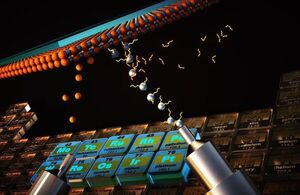
New technology will allow important metals to be made more efficiently
"University of Minnesota Twin Cities College of Science and Engineering researchers have invented a cheaper, safer, and simpler technology that will allow a “stubborn” group of metals and metal oxides to be made into thin films used in many electronics, computer components, and other applications. The research is published in the Proceedings of the National Academy of Sciences of the United States of America (PNAS), a peer-reviewed, multidisciplinary, high-impact scientific journal. The researchers worked with the University of Minnesota’s Technology Commercialization Office to patent the technology and have already garnered interest from industry. Many metals and their compounds must be made into thin films before they can be used in technological products like electronics, displays, fuel cells, or catalytic applications. “Stubborn” metals, however—which include elements like platinum, iridium, ruthenium, and tungsten, among others—are very difficult to convert into thin films because they require extremely high temperatures (usually more than 2,000 degrees Celsius) to evaporate. Typically, scientists synthesize these metal films using techniques like sputtering and electron beam evaporation." [...]
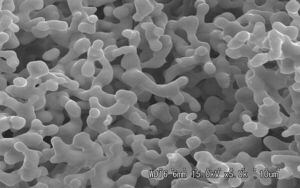
Polymer Coating Accelerates Fuel Production
"Researchers from the University of Tsukuba and Osaka University find that a polymer coating can effectively shuttle CO2 molecules to a metal catalyst, thus accelerating its product formation and offering potential greenhouse gas recycling strategies Tsukuba, Japan—It is well-established that the accumulation of greenhouse gases, like carbon dioxide (CO2), in the atmosphere contributes to climate change. Therefore, CO2 capture and recycling are vital for mitigating detrimental environmental effects and addressing the climate crisis. Recently, researchers from Japan designed a polymer-coated metal catalyst that accelerates CO2 conversion and offers green energy insights. In a study published in ACS Catalysis, researchers from the University of Tsukuba describe porous tin (Sn) catalysts coated with polyethylene glycol (PEG) and show how this polymer facilitates CO2 transformation into a useful carbon-based fuel. Various polymers can capture CO2 molecules, and Sn catalysts are known to reduce CO2 to other molecules, like formate (HCOO-), which can be reused to power fuel cells. "We were interested in combining these capabilities into a single catalytic system that could scrub CO2 from its surroundings and recycle it into formate," says research group leader, Professor Yoshikazu Ito." [...]
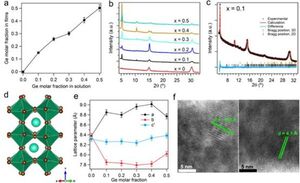
Germanium-lead perovskite LEDs: a new way to reduced toxicity
"Metal-halide perovskites are a new class of semiconductor materials for LED display and solar-energy harvesting. However, the best-performing devices are often made from lead (Pb)-based perovskites, whose toxicity may cause potential environmental concerns. To resolve the toxicity problem, an effective method has been the use of tin (Sn) as a partial or full replacement of lead in the perovskite materials. This strategy has been particularly successful for perovskite solar cells. However, tin-based (including tin-lead) perovskite materials are generally very poor light emitters, causing unsatisfactory performance of tin-based perovskite light-emitting devices (LEDs). A reason for this is that a high density of electronic defects can form during the preparation process of tin-based perovskites, as tin (Sn2+) can oxidize and the crystallization process is not well controlled." [...]

'Cleaner' catalytic converter to be developed in partnership with industry
"A new synthetic material that accelerates the removal of harmful nitrogen oxides and carbon monoxide from engine fumes is to be tested in a prototype catalytic converter. Scientists at Leeds who developed the material have announced a research collaboration with Cats and Pipes, an automotive company in North Wales that designs and manufacturers catalytic converters – devices fitted to the exhaust pipes of internal combustion engines to reduce toxic gas emissions. The aim is to have the prototype device fitted to a test vehicle by 2023, enabling its performance to be compared with current catalytic converters under real road conditions. The researchers believe the prototype has the potential to revolutionise catalytic converter technology. Exhaust fumes contribute to poor air quality in urban areas, which in turn is linked to chronic ill health and death. A report from Public Health England in 2019 estimated that between 28,000 and 36,000 people a year die from long-term exposure to air pollution." [...]
Patterning Silicon at the One Nanometer Scale
"The Science Researchers have developed an innovative technique for creating nanomaterials. These are materials only atoms wide. They draw on nanoscience to allow scientists to control their construction and behavior. The new electron beam nanofabrication technique is called plasmon engineering. It achieves unprecedented near-atomic scale control of patterning in silicon. Structures built using this approach produce record-high tuning of electro-optical properties." [...]

Scientists Design a Robotic Chameleon That Crawls and Changes Color
"A team of Korean researchers was so fascinated by chameleons that they made a robotic one, complete with googly eyes, a waddle-style gait and most importantly, a skin that changes color on demand. “It's walking around and also changing color at the same time,” says study author Seung Hwan Ko, a mechanical engineer at Seoul National University in South Korea. “So it's kind of like a full working chameleon.” The artificial electronic skin adjusts its hues instantly and automatically to match the background colors the robot crawls over. The invention, detailed today in the journal Nature Communications, is one of the first devices to change color and patterns based on its environment. It could also help scientists craft a new generation of active camouflage wear for military applications or help designers create fashion styles that flash different colors depending on nearby backgrounds. In addition to different colors, the robot can display several preprogrammed patterns on its exterior." [...]
Projetos Maker
Diversos Projetos interessantes.
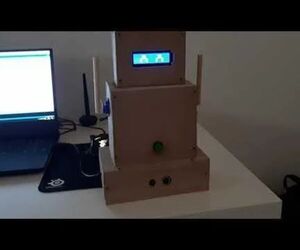
ITTT - Attention Wanting Robot - Mike Veldkamp 1D
"Welcome to this "If This Than That" project. For the final result of this project I made a small little wooden robot. The robot has different facial emotions depending on what's happening, if he is awake and you press the button on his head he becomes happy. If you don't stand infront of the sensor or give him attention he will become sad, and eventually even mad! In this Instructable I will talk about why I decided for this to be my end design / project and the steps I took to make this. Materials: - Arduino Uno R3 - Ultrasonic Sensor - 2x Micro Servomotor - LCD Display - 2x Button - Wooden planks (For body and arms) - Wood glue - Bolts Tools: - Hot glue gun - Screwdriver - Drill - Solderer Technical - PC / Laptop - Arduino Program (For code)" [...]

ZX80 Revisited With ESP8266 Program Loader
"ZX80 Computer revisited and adding program loading capability with an ESP8266 (ZXBrowser)" [...]
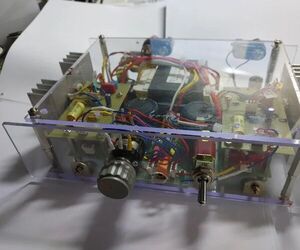
Audio Amplifier Using TDA2030A
"This is small power (about 14~18Watt) audio amplifier utilizing TDA2030 chip IC which is now obsolete. The TDA2030 was manufactured by STMicroelectronics that is joint electronic company between France and Italia. But analog audio device production had been stopped and this audio chip is no longer available. Meanwhile somehow I still have four TDA2030 ICs (maybe I bought these chips about 10 years ago and simply forgot to use) in my parts inventory. Although you cant buy TDA2030 any more, a general audio amplifier making method explain in this instructable can be still helpful to make other amplifier which using still available audio IC chip such as LM1875. Ill introduce other audio amplifier DIY project using LM1875 in another instructable later." [...]
Daily Running Tracker
"Hi All, It's been a while since I made an instructable so I'd like to share something fun that I made recently. During lockdown I made my own yearly "everyday calendar" inspired by Simon Giertz's own idea (no instructable but photo attached for those interested). My better half wanted something similar to track her running (but on a 7 day weekly basis rather than a year). It also had to keep track of how many miles she ran not just a single light indicating a task had been done or not. Additionally, I wanted it to sing and dance and do lots of shiny LED business when she exceeded her target. The idea for the daily running tracker was born, so in summary it must: - Log miles ran every day of the week - Compare 'miles ran' against a set goal for that day - Reward the user with a celebratory song and some flashy lights - Be small enough to fit on a desk - Remember everything when the power was turned off (comit everything to non-volatile memory) For this project I used: - A 3D printer (for the enclosure designed in FreeCAD) - M3 screws, and brass M3 inserts - A soldering iron - Jumper wires or wires of some kind - x9 momentary push buttons - x7 WS2812 addressable LED's - x7 SSD1306 OLED 128x32 pixel Displays - A 4 Ohm speaker - The DY-SV8F playback module - An Arduino Mega - DC barrel input - The TCA9548A multiplexer - Arduino Mega prototyping board" [...]
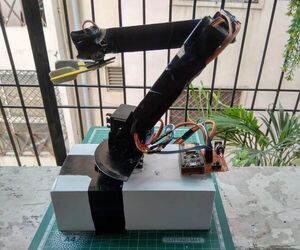
IoTRoboticARM
"The project is Robotic-arm controlled by a mobile application known as BLYNK, it is free and easy to use for automation and IoT projects for beginners. In this project multiple servo control different axes and rotation of the arm in a different direction. This project can be used where humans intervention is not possible, it can attach to a remote-controlled rover. It can carry radioactive stuff, turn on-off the switch, carry a light load, push-pull lever. Supplies 1. NodeMCU 2." [...]

Room Temperature Monitoring
"Raspberry Pi Pico Project Room Temperature Monitoring Using Dht 11 Sensor and 16 x 2. Lcd The project that I am currently working on is monitoring room temperature using a Raspberry Pi Pico, this tool is very useful for knowing the temperature and humidity in the room. This tool also uses a dht 11 sensor, where the DHT sensor is a sensor package that functions to measure air temperature and humidity as well as in which there is an NTC (Negative Temperature Coefficient) type thermistor to measure temperature, a humidity sensor with resistive characteristics to changes in water content in the air. and there is a chip inside that performs some analog-to-digital conversions and outputs a single-wire bi-directional format. besides Dht 11 I also use a 16 x 2 Lcd for the output display which is a data viewer module that uses liquid crystal as a material for displaying data in the form of writing or images. " [...]
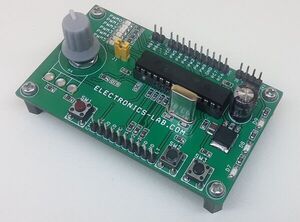
Development board for Brushless Motor, DC Brushed Motor, AC Motors (Pre-Driver)
"The project described here is a pre-driver for brushless motors with a hall sensor. The board incorporates many features like current monitor, fault, speed control, direction control motor start/stop using tactile switches, various function LEDs, 6 PWM LEDs. By combining it with a hybrid IC or IPM module large size high voltage and high current motor can be driven. The project is compatible with the Microchip PICDEM MCLV motor development board, HEX firmware of the MCLV board can directly work with this board. This board is mainly targeted to control brushless DC (BLDC) motors in hall sensor operations. The board supports a free, ready-to-use MC-GUI (Motor Control – Graphical User Interface) from Microchip." [...]

The Ultimate Logic Probe
"A small logic probe for CMOS and TTL circuits. Measures 5 states, detects pulses and can play different tones for the different states. Looking back through some of the stuff I have built over the years I came across a number of logic probes. Some worked better than others. One used sound to differentiate logic states, others had a 7 segment display that showed more states than those that had dual color or multiple LEDs, some only handled TTL logic levels etc. So in this project, I wanted to create the ultimate logic probe." [...]

Remote-Room-Radar
"Check the room occupancy by radar and communicate its status by Bluetooth (BLE) to next room. Why? Avoid meeting disturbance. Room planning can become a challenge - at home as well as in a company. And so it may happen, that two rooms will share one wall... although one room is requested to be quiet, while in the other some more action takes place, e.g. parent's bedroom next to the children's room - Or, like the original reason for this project, caused by a building reconstruction the new cafeteria area was next to a meeting room." [...]

Long term dust monitoring system
"Monitor the surrounding dust and large particle (>0.5µm) for long time using Blynk IOT and plot the data for further research. In this project I have made a IOT based Dust density monitor which can measure the surrounding dust and send the data through internet and I can graphically monitor the long term value of the dust density in a place. This can helps to make future project like improving the air pollution and many other projects. Sharp gp2y1014au0f is a particulate sensor uses an IR LED and when the particle in the air enters into the sensor the light bounce off towards a photo-detector. This technique is called laser scattering. The intensity of the scattered(Bounced) light depends on the dust particles." [...]

Control LEDs ON/OFF With 433MHz RF Remote and Arduino
"In this simple tutorial we will learn how to turn ON/OFF 4 LEDs with a 433MHz RF Remote and Arduino. What you need: - Arduino UNO (or any other Arduino) - Jumper wires - 4 X LED - 4 X 1K ohm Resistor - Breadboard - 433 MHz RF module - Visuino program: Download Visuino" [...]
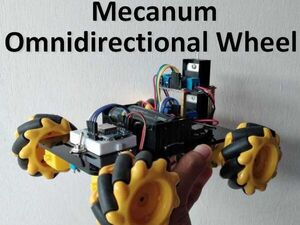
Mecanum Wheel... Omni Direction Wifi RC Car
"Step by step how to build an RC Car with Mecanum Wheel. It makes the car can go to any direction by pressing the smartphone's buttons Hello everybody. In this project, I would like to share how to build an RC car using Mecanum Wheel. Mecanum wheel is an omnidirectional wheel that can move to any direction. Mecanum wheel often called as Swedish wheel or Ilon wheel (as the name of the inventor and the company where this wheel is coming from). This wheel is special designed, so the shape has difference compare to the normal wheel." [...]

Digital Clock using Arduino Nano
"Digital Clock with Hour/ Minute/Second Display, Alarm and Hour chime using Arduino Nano and RTC DS3231. Iam a first time user of Arduino, and I actually made this project to learn programming of micro controllers. Though several digital clocks projects are seen online most of them are not having all features like seconds display, hour chime, alarm etc. Also in most of the clock projects the Alarm set time goes off when disconnected from the supply. I have incorporated all these features in my project, and I think its worth to share it with the community. Apart from Arduino Nano and DS 3231 RTC, all the other components were taken from scrap circuit boards." [...]

Pico Solar System
"Hardware - Raspberry Pi Pico - Precision RTC Module (DS3231) - Pico Display Pack Software MicroPython The software is written in MicroPython 1.15 and uses a custom build from Pimorony which includes drivers for the display. Download it from the official Pimorony repository here. - Download the MicroPython UF2. - Push and hold the BOOTSEL button and plug your Pico into the USB port of your computer. Release the BOOTSEL button after your Pico is connected. - It will mount as a Mass Storage Device called RPI-RP2." [...]

T.O.F. Wristband V2
"An assistive device for visually imparied people, it measures the distance between the user's wrist to obstacles and vibrates proportionally The new version of an open source assistive device for visually imparied people, It measures the distance between the user's wrist and an obstacle and vibrates with intensity proportional to the distance. It is battery powered (there is a small Lipo inside, that you can recharge with a microUSB cable), quite compact, and both the body and the bracelet can be 3D Printed. It can be useful for situations where a white cane is less practical (crowded places, places like inside a tram or metro, ecc). This is a wristband that can help for visually imparied people,. The idea is that you have it on your wrist, and it vibrates when it is pointed to anyobject closer than 4 meters. And it will signal that by vibtrating (thanks to its internal vibrating disc), with a frequency proportional to the distance." [...]
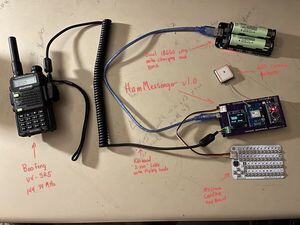
HamMessenger
"HamMessenger is a portable, battery powered device that runs on a microcontroller and interfaces with an inexpensive ham radio to send and receive text messages and provide position updates using the APRS protocol. Messages and position updates sent via HamMessenger can be viewed on sites such as aprs.fi. HamMessenger messages are NOT encrypted! HamMessenger is intended to be used by licensed ham radio operators. For more information you can check out the ARRL website. The goal of the HamMessenger project is to create a device that uses ham radio as a medium for sending and receiving text messages." [...]
Secção Videos
Videos interessantes.
That's all Folks!



